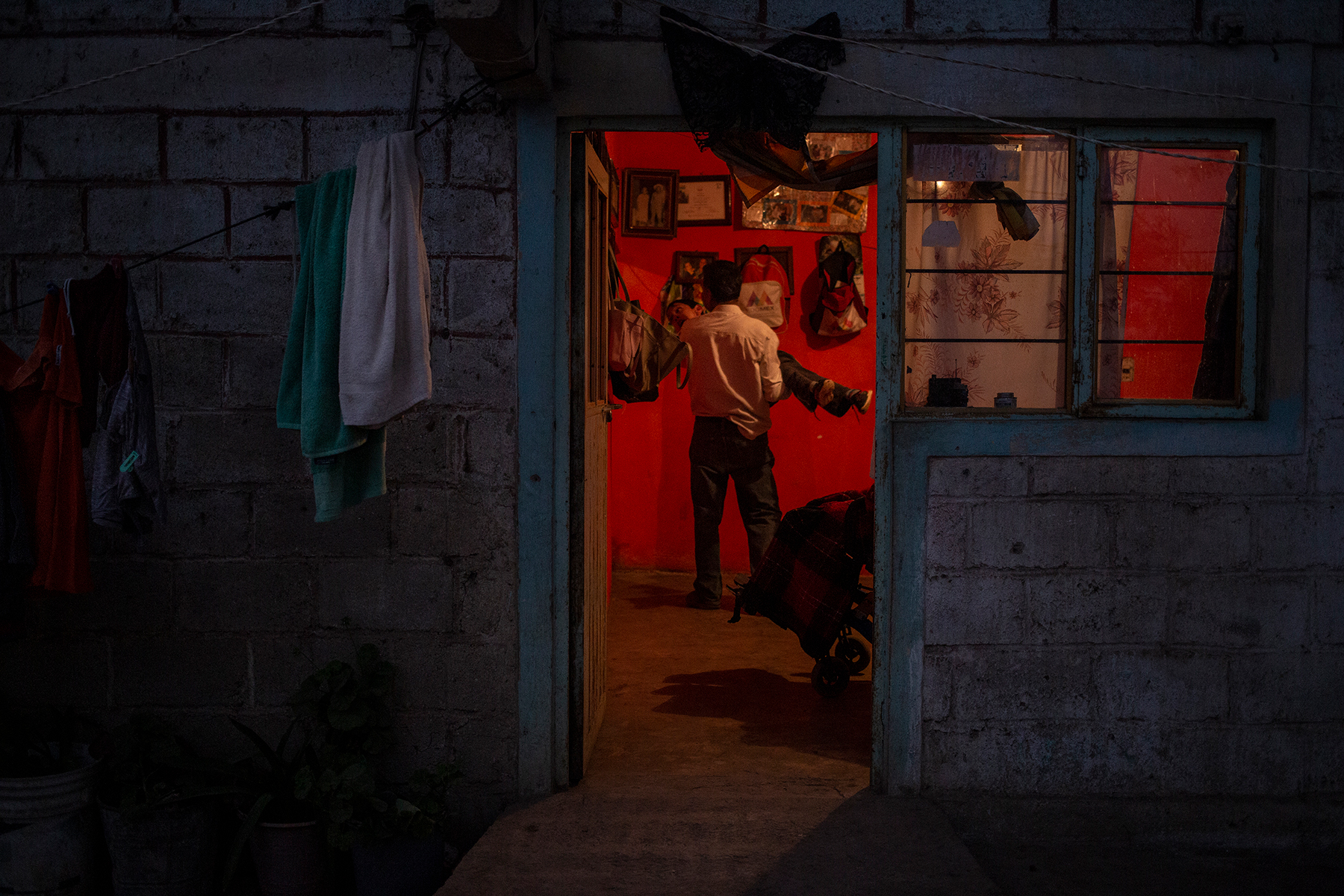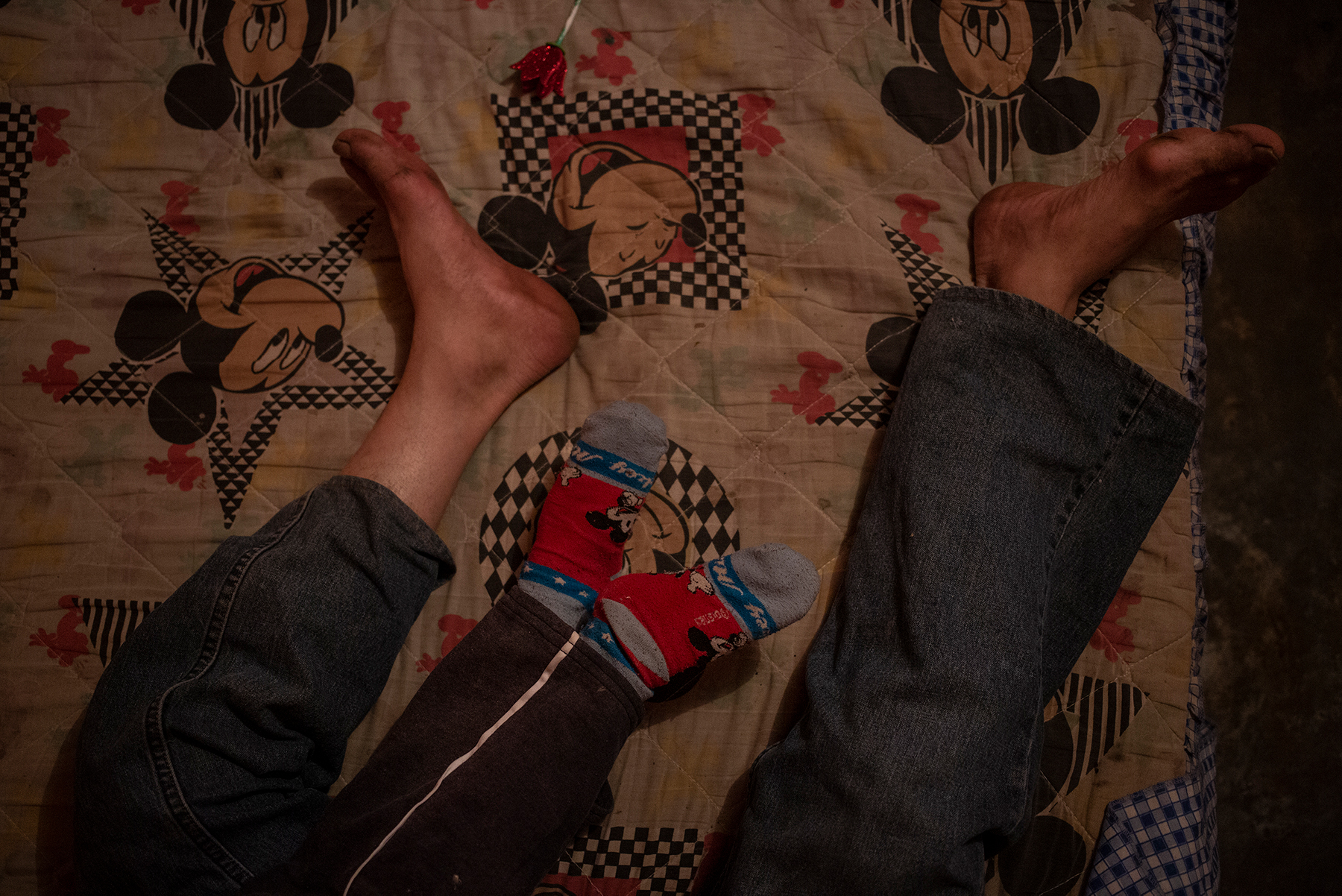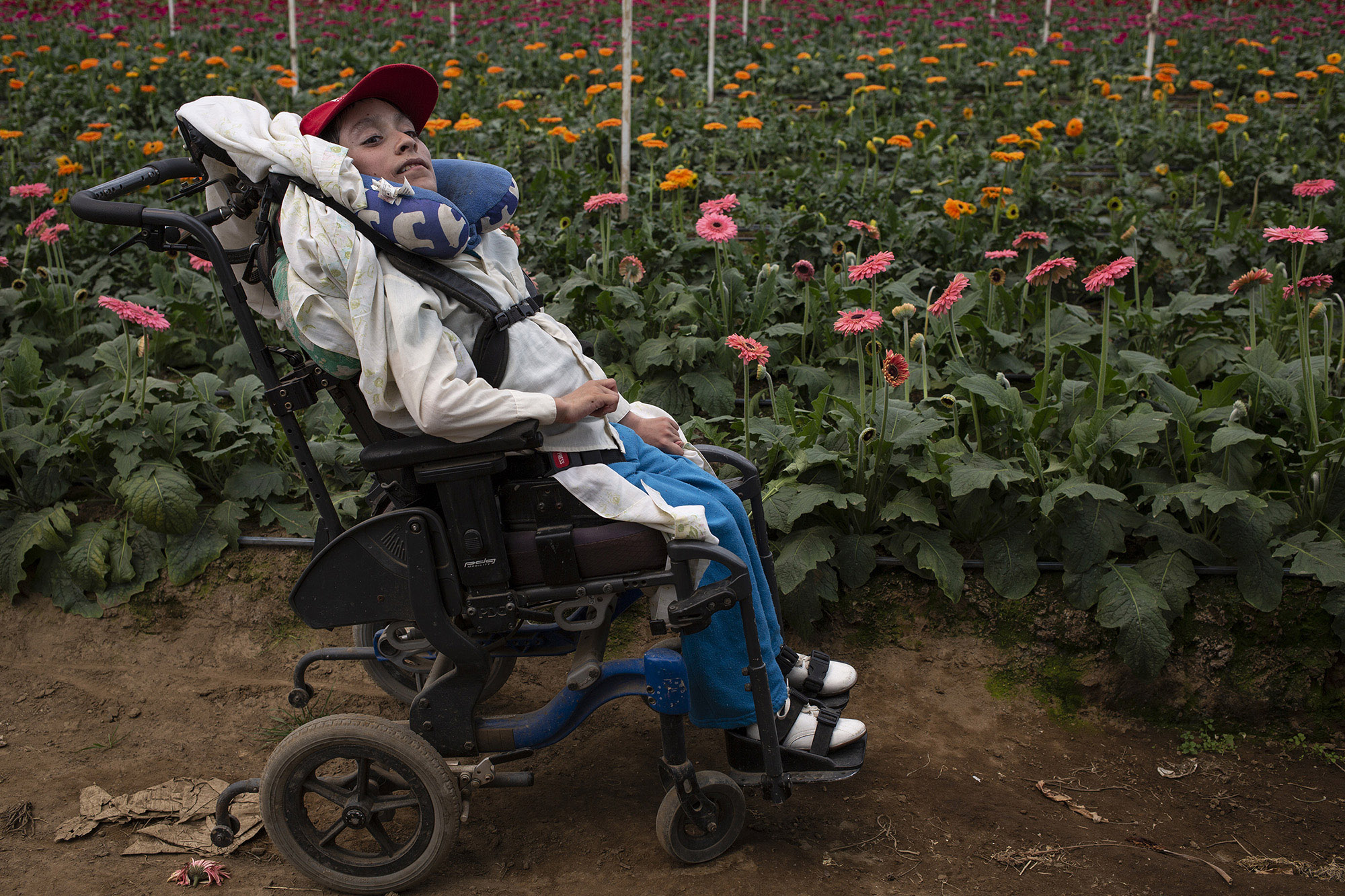What does a field of roses smell like? The answer is not romantic: it stinks of pesticides. In order for natural flowers to be perfect and last longer in a market in the United States, in Villa Guerrero, in Mexico, the fields and streets of the town are impregnated with the smell of freshly fumigated fields. Everyone depends on flowers, and most of them know that after work they have to bathe well, that the least contact with chemicals is a passport to the hospital. When photographer Cristopher Rogel Blanquet began working on the subject, he encountered children with hydrocephalus, people who were born with tumors or with spina bifida. People who survive around the flower industry, and who pay with their body to be surrounded by pesticides.
When Villa Guerrero is searched on Google maps, the satellite image that appears seconds later shows huge patches of white rectangles between some green and yellow patches, all crossed by gray lines. These are large areas of greenhouses, one after the other. Villa Guerrero is part of the so-called floricultural region in Mexico.
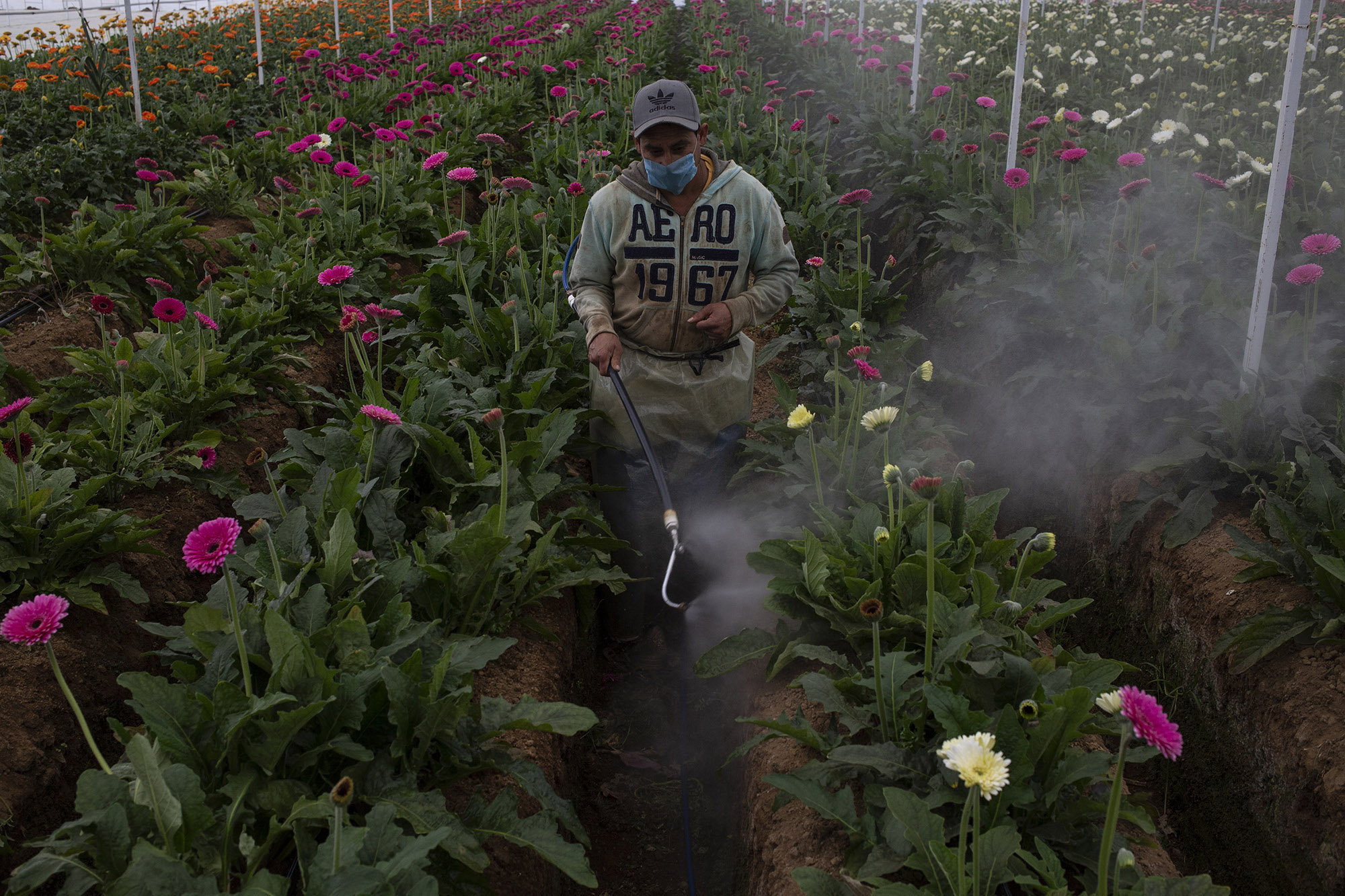
Te municipalities of Coatepec Harinas, Ixtapan de la Sal, Tenancingo, Tonatico, Villa Guerrero and Zumpahuacán, in the State of Mexico, are part of this region. Flower cultivation is traditional there, but it was boosted by the arrival of Japanese migrants in the mid-20th century. They started greenhouse flower cultivation and increased production. In a short time the area became the epicenter of floriculture in the country, the Japanese left the scene, but the cultivation was strengthened with the entry of large agro-industries. Most of the production of large companies leaves the country, mainly to the United States and small producers have local market niches.
Gerberas, roses, tulips, lilies, carnations, gladioli. More than 50% of the national flower production is grown in this region. In Villa Guerrero, at least 70% of the population works in flower crops. Cristopher Rogel Blanquet knows this reality closely.
Last year, looking for possibilities to broaden his work horizons, he contacted one of the Reuters editors, who suggested that he propose a job related to climate change, thus he started Hermoso veneno. Cristopher remembered the ranches dedicated to flower growing and the people who worked there. He had heard that among the most common practices in crops was the use of different types of agrochemicals, very toxic to health.
Cristopher started looking and found the case of Sebastián, an 18-year-old boy who was born with hydrocephalus. He contacted his family and during this time he has been building a relationship with them. Sebastián’s family attributes his condition to contact with pesticides. It is not the only case and, in fact, other types of conditions and malformations occur in the area. According to researchers from the Universidad Autónoma del Estado de México, 65% of cases of fetal mortality due to anencephaly and approximately 80% of infant mortality due to spina bifida could be avoided if contact with pesticides were reduced.
In flower crops, different types of herbicides, fungicides and insecticides are used, all with a single objective: “to have the most beautiful and most perfect flower. Why? Because that’s how the people who buy them want it. “
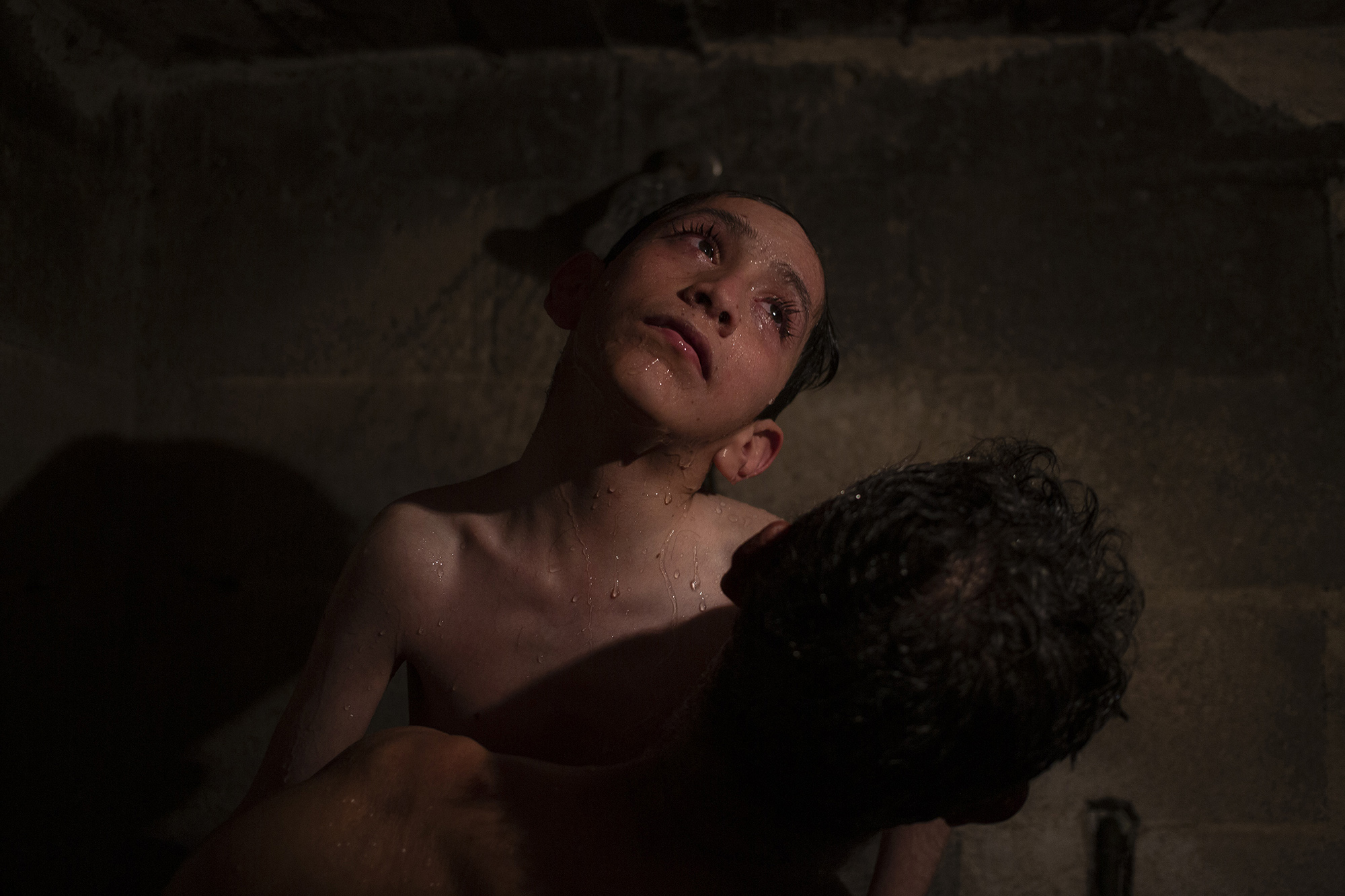

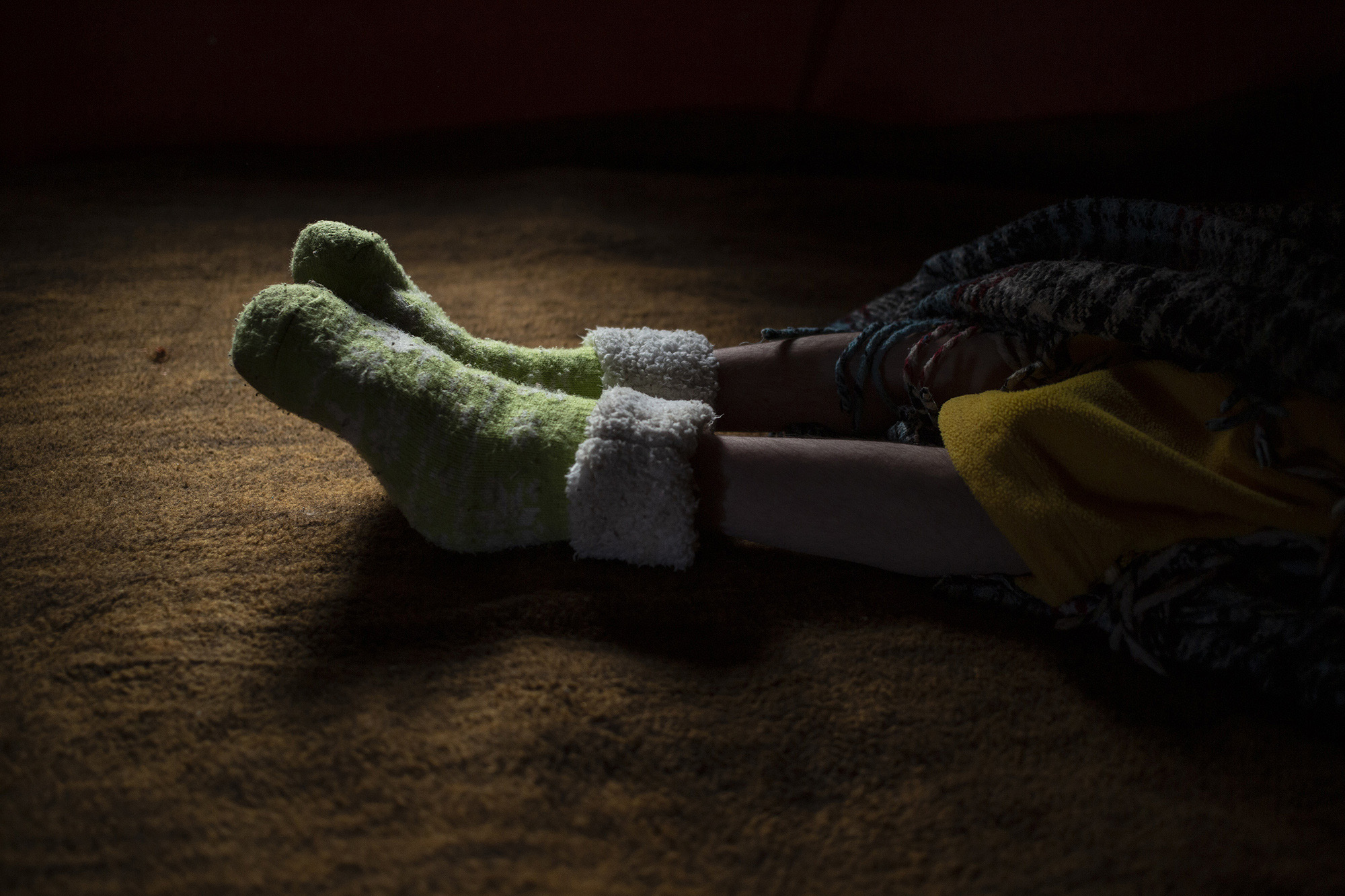

How did you get to this topic?
I’ve been taking photos for ten years, more or less. For 6 years I was part of the staff of El Universal which is the most important newspaper in Mexico. That was during Peña Nieto’s six-year term, from there I work independently and I have tried to diversify my view in order not to pigeonhole myself only with daily journalism. Throughout these years I have done more long-term and intimate projects, I want to tell these stories, not so immediate, but to take the time to address each one. As you progress you realize that things are happening that you might not be able to perceive if you are in a newspaper as such.
Right now I am documenting the use of agrochemicals because it was a topic that Reuters editor Claudia Daut suggested to me at that time. And well, in an effort to get into Reuters, I started doing it. But it is a work in which I was suddenly immersed and I continued working, already with a more intimate look, more from the characters and trying not to be sensationalist in the sense that although it is true that I am portraying people who were born with congenital problems, I try to do it with dignity.
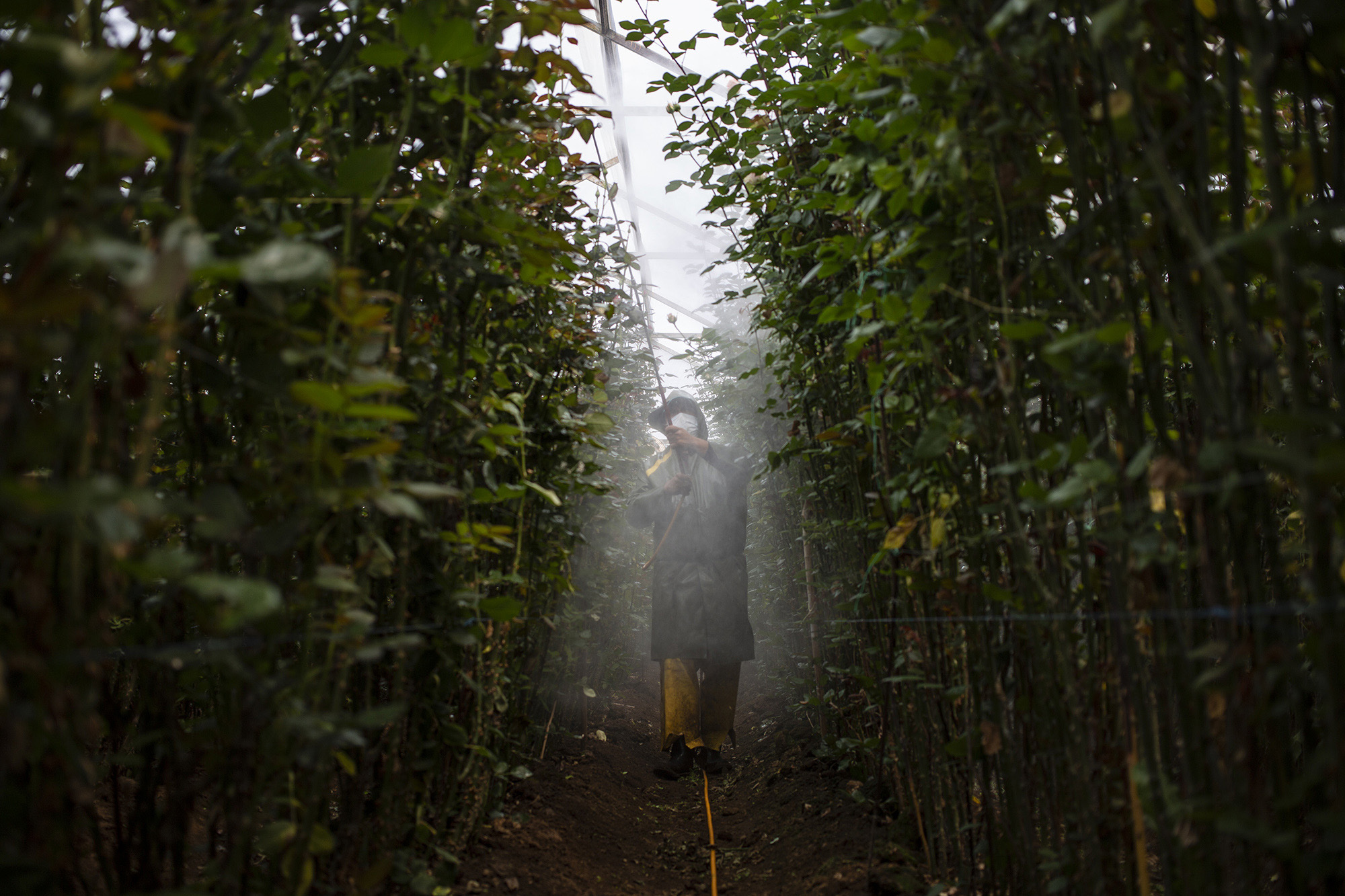

Why did you choose Villa Guerrero?
I’m no stranger to that context. I have always known all the economic activity of the flower that exists in the region. Since before I dedicated myself to journalism, I remember hearing people say that there was a serious health problem there because people worked with pesticides, that nothing was said but it was suspected that this was not going to end well.
So when I went to Reuters, she told me that the theme for 2020, before the pandemic started, was going to be climate change and she recommended that I do a project on that. It was then that I remembered this situation and decided to work on agrochemicals. I had access because I am no stranger, I know how to move in the area and I began to investigate if there were articles that talked about that and I realized that there were some reports that had been done in the media about ten years ago, where they addresed the point, but it did not pass beyond those notes. There are some studies from the Universidad Autónoma del Estado de México that talk about contamination caused by agrochemicals and that’s where I started to track down to find out if they had an acquaintance or knew the acquaintance of an acquaintance who was affected.
That’s how I got to Sebastián, who had a report on him a long time ago. Asking I got to him, and then after being able to talk to his parents, they welcomed me. I’m talking to you that this process took several months. I was at Sebastián’s house for a week and I started documenting. That was my first approach.
Through Sebastián I found another case, it is about Don José, who was born with a tumor on his back. Among all the complications he has had from the tumor, they had to remove one foot and rebuild the other. And well, to date he is dedicated to spraying and growing flowers.
With my work I do not want to stigmatize the cultivation of the flower because it is clear to me and I understand that many thousands of people make a living from it. There are very high levels of wealth in Villa Guerrero, and also poverty, but everyone, from the poorest to the richest in the area, dedicates themselves to the flower in any of its ramifications. Rather, I want to encourage less use of agrochemicals, perhaps using organic fertilizers. But also that this has a vibration towards consumers, because agrochemicals and everything they put on flower crops have only one purpose: to have the most beautiful and most perfect flower. Why? Because that’s how the people who buy flowers want it.
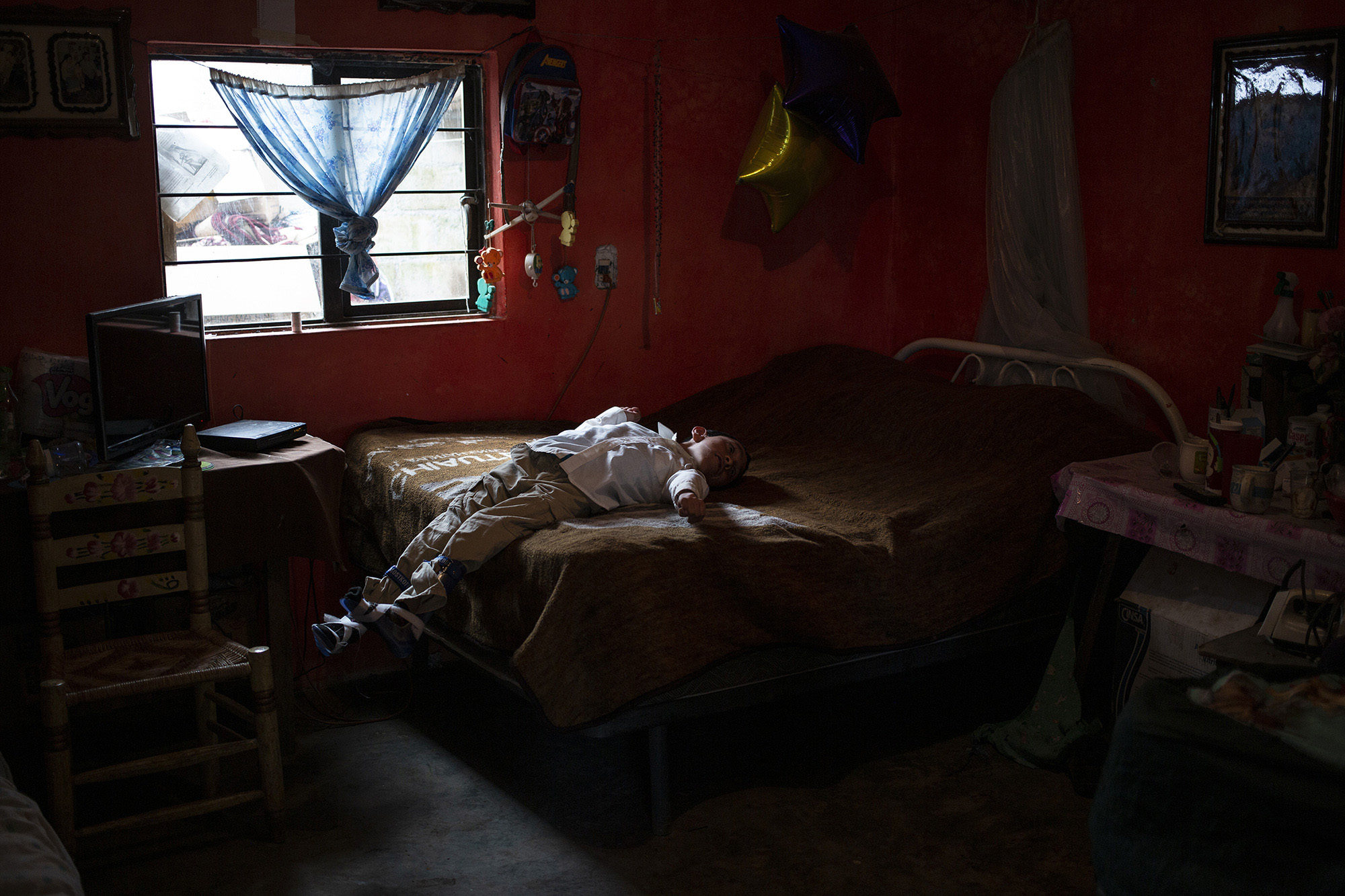

There are studies by university professors who talk about the active components of agrochemicals and in the list of possible diseases that it could cause hydrocephalus, spina bifida and tumors are the ones that are always present. It is delicate, from my point of view, that most of the affected people do not associate or do not want to associate their conditions with the agrochemical context. At least the people with whom I have been able to speak and who have a condition, except Sebastián, do not attribute their problem to the use of agrochemicals. For example, José, who was born with a tumor, says that he went for something else. Another boy who was also born with spina bifida, says it is because his mother told him that the day he was born there was an eclipse. Things like that.
But there it is. In other words, when you go to a field of flowers or a floricultural region, from the moment you arrive it smells of pesticides, and not only in the fields, between the streets of the town, between the houses it stinks of agrochemicals.
And no matter how much they deny it, when you start to get into the area you realize that in this house a child has hydrocephalus and two houses there, a man was born with a tumor and the other guy has spina bifida . And in the next street there is a boy who has a condition similar to Sebastian’s. As there are many tragic coincidences so that there are in the same locality, many people with congenital problems.
Could you tell me a little more about the agrochemicals used in this region?
They call them fumigantes, and they use it for a lot of things, from preventing pests such as the white spider, or the fly, to making the flowers grow better, do not dehydrate, do not burn, do not get spots. It is a bottle cocktail, normally they spray every Saturday and it is by sprinkling.
It is done in two ways. In one they fill these big drums with water where they make all the broth and then with a pump and a long hose, they start to fumigate piece by piece. Someone runs all the furrows to spray the flowers. And in the other, which is almost not used, but is still seen, in small producers, are these pumps that are placed on the back and manually pump and disperse the liquid.
Everyone knows that it hurts you. When I documented the fumigations I was staying at Sebastián’s house, and when I arrived they told me to bathe and do it well because if for any reason you consumed something or were too exposed, you could vomit. It is very common for them to go to the hospital after spraying if certain measures are not taken due to direct exposure to the chemicals.
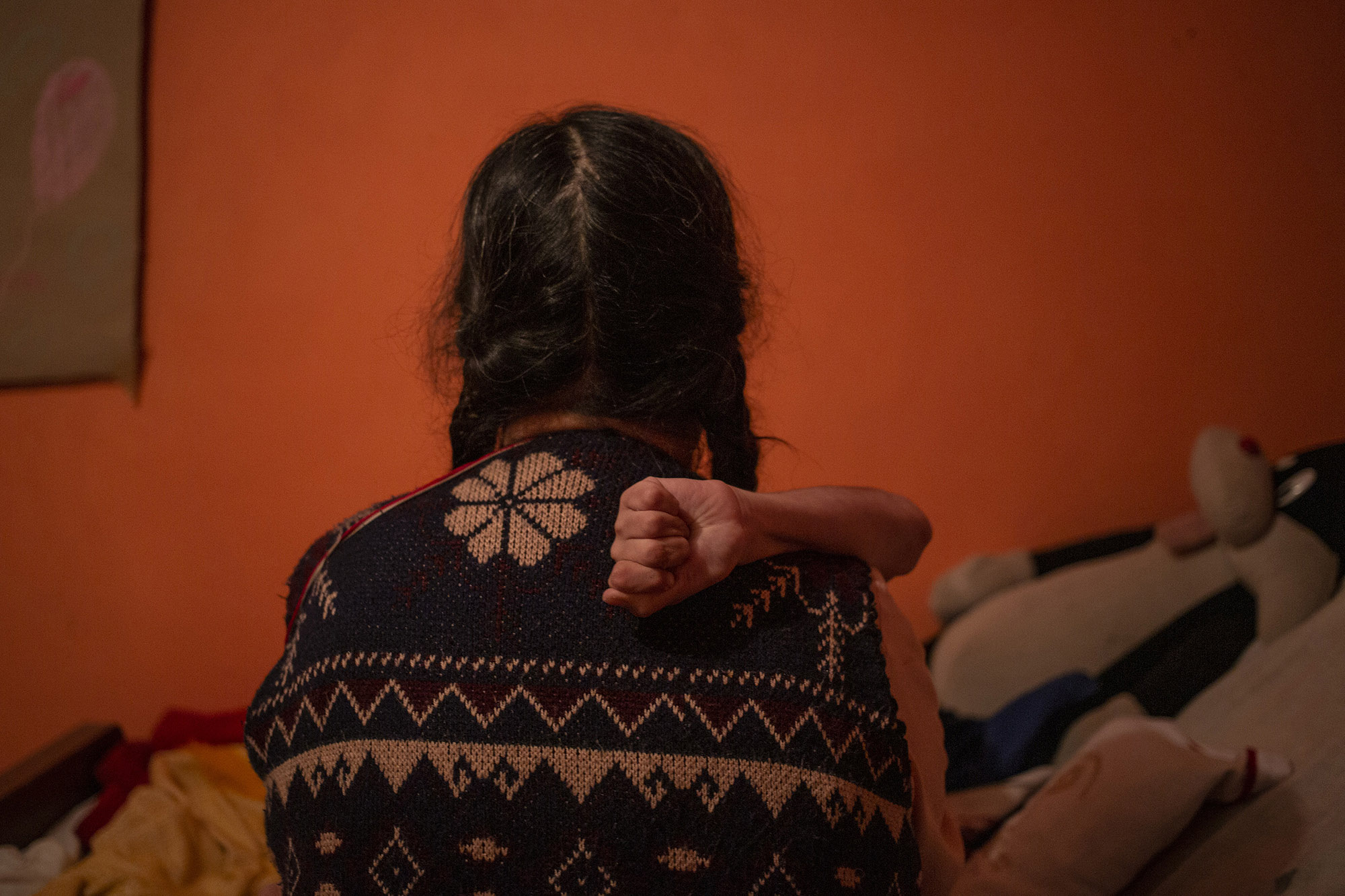

Even so, it is very striking that they do not make the correlation between certain conditions and diseases and contact with agrochemicals.
They know that there is a problem and that there is a relationship of damage, because even for some time now there are already containers of fumigant residues in the localities. This means that all the empty bottles that people has used, have to be discarded there, just so that later the specialists or those in charge of collecting this waste arrive and take them to process this waste, not as normal garbage. They obviously know that it is dangerous. But hey, they do not associate 100% of the ills or they do not suspect that there are many people with congenital problems in the area because of the agrochemicals. That’s the problem. In the end this is their economic activity.
In your photos you can see people working on and spraying crops.
Well, that’s what they do. The people live on that, from the great landowner to the landowner’s laborer, who in turn sows flowers in the courtyard of his house. It is part of the economic activity. Sebastián’s mother told this: “I know is bad, but this is what we live on. What are we going to do?” That is his argument or their consolation, I don’t know.
What I want is not to stigmatize the activity. I think rather we have to change the processes, because many people make a living from that. So part of my project that I am following up and I have planned for at least two years, is also to show the other side: those beautiful flowers in the stores.



Could you talk a little more about the characters and their families?
Sebastián is 18 years old, although you see him and he looks like a child, he was born with hydrocephalus. His parents to date have dedicated themselves to the cultivation of the flower. Sebastián’s father, Don Florentino, says that the doctors did not give him a life expectancy beyond five years. And he presumes that if Sebastián has been able to reach this age it is because they have accepted him and they have not rejected him, because they love him. Basically love is what keeps him alive.
The other person I just met is José. He is like a kind of distant uncle of Sebastián, he must be 40 years old. He was born with a tumor in his spine and from there they did something to his foot that didn’t work. Both Don Florentino and himself are dedicated to growing flowers.


